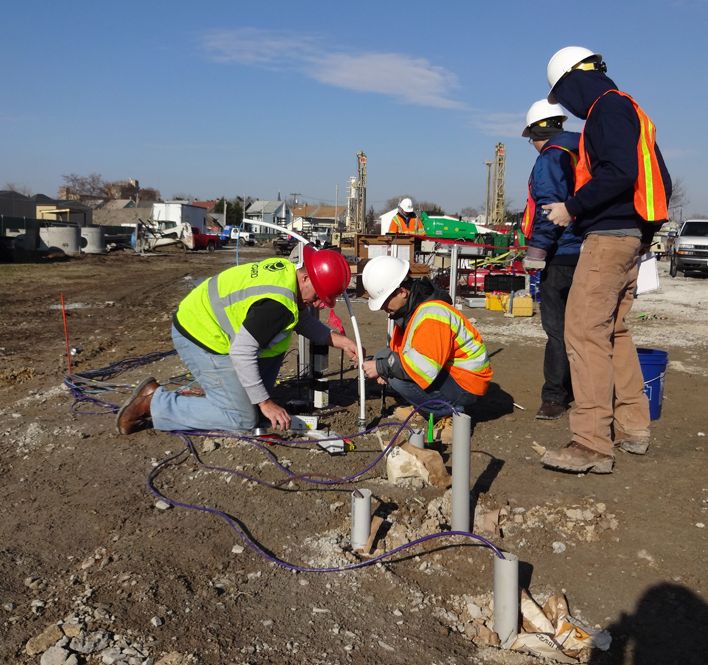Specialized Geotechnical Works for Sustainable Building Solutions
Exploring the Essential Role of Consulting Engineers in Geotechnical Projects: An Extensive Overview of Their Payments and Obligations
Consulting engineers serve as pivotal figures within geotechnical projects, charged with the detailed obligations of evaluating subsurface conditions and ensuring the structural honesty of building and constructions. Their experience not only forms style parameters and governing compliance yet likewise helps with critical interaction among different stakeholders, thereby boosting project end results. The complexity of their duty is further emphasized by the need for aggressive danger monitoring techniques and ecological considerations. As we discover the multifaceted payments of consulting designers, it comes to be apparent that their participation is important to browsing the challenges intrinsic in geotechnical undertakings. What particular approaches do these professionals utilize to guard project success?
Review of Geotechnical Design
Geotechnical design is a crucial self-control within civil engineering that concentrates on the habits of planet products and their communication with frameworks. This field includes the study of dirt, rock, groundwater, and the technicians governing their buildings and actions. Geotechnical designers assess the physical and chemical residential or commercial properties of these materials to determine their suitability for various construction tasks, making certain that frameworks are started on steady and trustworthy ground.

Moreover, geotechnical designers should consider environmental variables, such as soil contamination and groundwater monitoring, to promote lasting development. Their know-how is important in maximizing the design and building processes, inevitably contributing to the longevity and security of civil engineering jobs.
Key Obligations of Consulting Engineers

Additionally, they are in charge of developing layout criteria and requirements that follow regulative requirements and finest practices. This includes evaluating website problems and figuring out suitable construction methods, which is crucial for decreasing threats connected with ground instability.
Consulting designers also work as liaisons between different stakeholders, including customers, professionals, and regulatory bodies, promoting clear communication and collaboration throughout the job lifecycle. consulting civil engineering companies. They give professional support during building, making certain that geotechnical aspects are appropriately dealt with and that any type of unforeseen challenges are taken care of efficiently. Eventually, the diverse this hyperlink duties of speaking with designers are basic to the integrity and success of geotechnical jobs, affecting both safety and security and sustainability in construction methods
Website Analyses and Examinations
A comprehensive site evaluation is crucial for understanding the subsurface conditions that influence geotechnical jobs. Consulting engineers play an essential duty in performing these analyses to ensure the security and feasibility of building and construction tasks. This procedure typically involves a series of investigations, including soil tasting, borehole drilling, and geophysical studies, to collect critical information on soil residential properties, groundwater degrees, and the geological context of the website.
Engineers examine the acquired data to identify the prospective challenges positioned by the subsurface conditions, such as soil instability or high groundwater degrees, which can affect the layout and implementation of the task. Additionally, website assessments aid in examining the existence of contaminants, which is essential for environmental compliance and ensuring public security.
Additionally, consulting designers coordinate with multidisciplinary teams to integrate searchings for from site examinations into broader project objectives. Through rigorous documentation and coverage, they offer crucial understandings that inform stakeholders about the suitability of the site for recommended developments. Inevitably, the thoroughness of site analyses lays the structure for effective preparation and engineering remedies, mitigating threats connected with unexpected subsurface conditions.
Design and Threat Administration
After carrying out detailed site assessments, speaking with designers focus on the style and risk administration facets of geotechnical projects. why not try these out This phase is critical as it makes certain that the engineered options are not just reliable but additionally safe and sustainable (consulting civil engineering companies). Engineers use their know-how to create layouts that attend to the particular geotechnical conditions identified throughout the site assessments, including soil residential or commercial properties, groundwater habits, and potential risks
Danger administration is integral to this process, as it involves identifying, examining, and mitigating prospective dangers related to the job. Engineers use various logical techniques and modeling methods to forecast the actions of dirt and rock under various loading conditions. By assessing unpredictabilities and prospective failure modes, they can recommend design modifications that enhance stability and minimize danger.
Additionally, speaking with engineers ensure compliance with relevant codes and standards, which are necessary for reducing obligations. They also prepare contingency plans to resolve unanticipated obstacles that may emerge throughout building. With precise layout and proactive risk monitoring, speaking with engineers play a vital duty in making certain the security, performance, and durability of geotechnical jobs, ultimately adding to the total success of the construction endeavor.
Cooperation With Task Stakeholders
Efficient collaboration with task stakeholders is important for the success of geotechnical projects. Consulting designers play a pivotal role in promoting communication among different celebrations, including customers, service providers, regulatory authorities, and ecological experts. This cooperation ensures that all stakeholders have a clear understanding of project goals, timelines, and potential threats.
Consulting designers are accountable for integrating stakeholder input into the layout and implementation of geotechnical options - consulting civil engineering companies. By actively engaging with stakeholders, they can identify concerns early in the job lifecycle, enabling timely adjustments and mitigating possible conflicts. This aggressive method not only promotes depend on yet likewise enhances project effectiveness
In addition, getting in touch with designers must navigate the complexities of regulative conformity, making certain that all geotechnical methods align with legal and environmental standards. Their expertise around is critical in preserving open lines of interaction with regulatory bodies, thereby promoting smoother approvals and permitting processes.
Conclusion
